经典版说明书(最新修改)
产品使用说明书模板
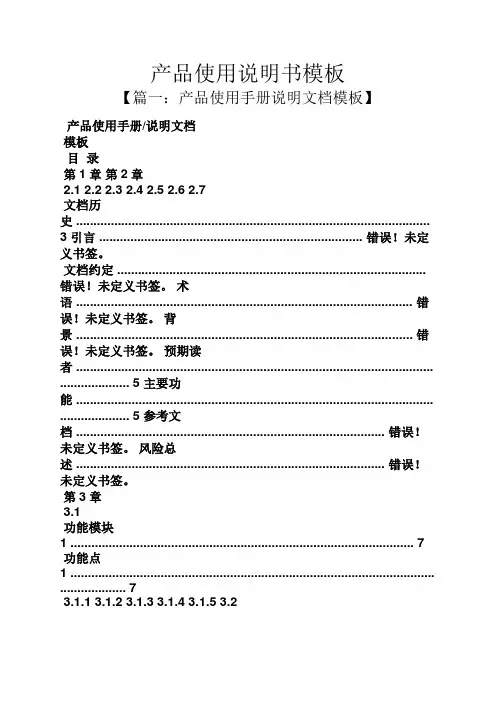
产品使用说明书模板【篇一:产品使用手册说明文档模板】产品使用手册/说明文档模板目录第1章第2章2.1 2.2 2.3 2.4 2.5 2.6 2.7文档历史 ......................................................................................................3 引言 ............................................................................ 错误!未定义书签。
文档约定 ......................................................................................... 错误!未定义书签。
术语 ................................................................................................. 错误!未定义书签。
背景 ................................................................................................. 错误!未定义书签。
预期读者 ....................................................................................................... .................... 5 主要功能 ....................................................................................................... .................... 5 参考文档 ......................................................................................... 错误!未定义书签。
Java Card平台虚拟机规范(经典版)v3.2说明书
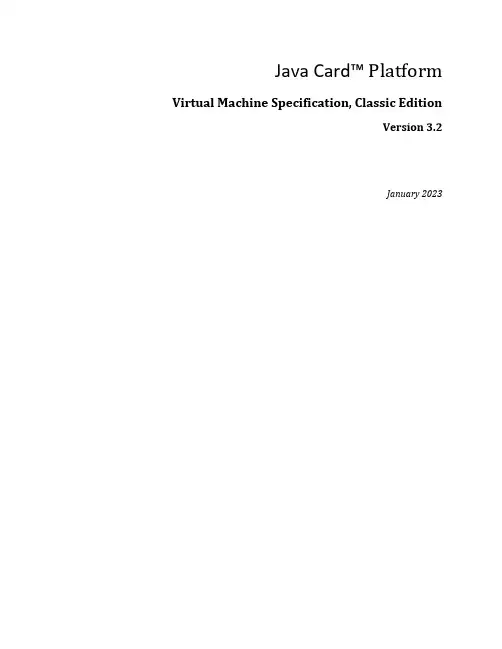
Java Card™Platform Virtual Machine Specification, Classic EditionVersion 3.2January 2023Java Card Platform Virtual Machine Specification, Classic Edition Version 3.2Copyright © 1998, 2023, Oracle and/or its affiliates. All rights reserved.The Specification provided herein is provided to you only under the Oracle Technology Network Developer License included herein as Annex A - Oracle Technology Network Developer License Terms.License Restrictions Warranty/Consequential Damages DisclaimerThis software and related documentation are provided under a license agreement containing restrictions on use and disclosure and are protected by intellectual property laws. Except as expressly permitted in your license agreement or allowed by law, you may not use, copy, reproduce, translate, broadcast, modify, license, transmit, distribute, exhibit, perform, publish, or display any part, in any form, or by any means. Reverse engineering, disassembly, or decompilation of this software, unless required by law for interoperability, is prohibited.Warranty DisclaimerThe information contained herein is subject to change without notice and is not warranted to be error-free. If you find any errors, please report them to us in writing.Restricted Rights NoticeIf this is software or related documentation that is delivered to the U.S. Government or anyone licensing it on behalf of the U.S. Government, then the following notice is applicable:U.S. GOVERNMENT END USERS: Oracle programs, including any operating system, integrated software, any programs installed on the hardware, and/or documentation, delivered to U.S. Government end users are "commercial computer software" pursuant to the applicable Federal Acquisition Regulation and agency-specific supplemental regulations. As such, use, duplication, disclosure, modification, and adaptation of the programs, including any operating system, integrated software, any programs installed on the hardware, and/or documentation, shall be subject to license terms and license restrictions applicable to the programs. No other rights are granted to the U.S. Government.Hazardous Applications NoticeThis software or hardware is developed for general use in a variety of information management applications. It is not developed or intended for use in any inherently dangerous applications, including applications that may create a risk of personal injury. If you use this software or hardware in dangerous applications, then you shall be responsible to take all appropriate fail-safe, backup, redundancy, and other measures to ensure its safe use. Oracle Corporation and its affiliates disclaim any liability for any damages caused by use of this software or hardware in dangerous applications.Trademark NoticeOracle and Java are registered trademarks of Oracle and/or its affiliates. Other names may be trademarks of their respective owners.Intel and Intel Xeon are trademarks or registered trademarks of Intel Corporation. All SPARC trademarks are used under license and are trademarks or registered trademarks of SPARC International, Inc. AMD, Opteron, the AMD logo, and the AMD Opteron logo are trademarks or registered trademarks of Advanced Micro Devices. UNIX is a registered trademark of The Open Group.Third-Party Content, Products, and Services DisclaimerThis software or hardware and documentation may provide access to or information about content, products, and services from third parties. Oracle Corporation and its affiliates are not responsible for and expressly disclaim all warranties of any kind with respect to third-party content, products, and services unless otherwise set forth in an applicable agreement between you and Oracle. Oracle Corporation and its affiliates will not be responsible for any loss, costs, or damages incurred due to your access to or use of third-party content, products, or services, except as set forth in an applicable agreement between you and Oracle.Documentation AccessibilityFor information about Oracle's commitment to accessibility, visit the Oracle Accessibility Program website at /pls/topic/lookup?ctx=acc&id=docacc.Access to Oracle SupportOracle customers that have purchased support have access to electronic support through My Oracle Support. For information, visit /pls/topic/lookup?ctx=acc&id=info or visit/pls/topic/lookup?ctx=acc&id=trs if you are hearing impaired.ContentsPreface (19)Who Should Use This Specification (19)Before You Read This Specification (19)Shell Prompts (19)Typographic Conventions (20)Related Documentation (20)Third-Party Web Sites (20)Documentation Accessibility (21)Access to Oracle Support (21)Oracle Welcomes Your Comments (21)1Introduction (22)1.1 Motivation (22)1.2 The Java Card Virtual Machine (23)1.3 Java Language Security (25)1.4 Java Card Runtime Environment Security (25)2 A Subset of the Java Virtual Machine (27)2.1 Why a Subset is Needed (27)2.2 Java Card Platform Language Subset (27)2.2.1 Unsupported Items (27)2.2.1.1 Unsupported Features (27)2.2.1.1.1 Dynamic Class Loading (27)2.2.1.1.2 Security Manager (28)2.2.1.1.3 Finalization (28)2.2.1.1.4 Threads (28)2.2.1.1.5 Cloning (28)2.2.1.1.6 Access Control in Java Packages (28)2.2.1.1.7 Typesafe Enums (28)2.2.1.1.8 Enhanced for Loop (29)2.2.1.1.10 Runtime Visible Metadata (Annotations) (29)2.2.1.1.11 Assertions (29)2.2.1.2 Unsupported Keywords (29)2.2.1.3 Unsupported Types (29)2.2.1.4 Unsupported Classes (29)2.2.1.4.1 System (30)2.2.2 Supported Items (30)2.2.2.1 Supported Features (30)2.2.2.1.1 Packages (30)2.2.2.1.2 Dynamic Object Creation (30)2.2.2.1.3 Virtual Methods (30)2.2.2.1.4 Interfaces (30)2.2.2.1.5 Exceptions (30)2.2.2.1.6 Generics (31)2.2.2.1.7 Static Import (31)2.2.2.1.8 Runtime Invisible Metadata (Annotations) (31)2.2.2.2 Supported Keywords (31)2.2.2.3 Supported Types (32)2.2.2.4 Supported Classes (32)2.2.2.4.1 Object (32)2.2.2.4.2 Throwable (32)2.2.3 Optionally Supported Items (32)2.2.3.1 Integer Data Type (33)2.2.3.2 Object Deletion Mechanism (33)2.2.4 Limitations of the Java Card Virtual Machine (33)2.2.4.1 Limitations of Packages (33)2.2.4.1.1 Packages in a Java Card CAP file (33)2.2.4.1.2 Package References (33)2.2.4.1.3 Package Name (33)2.2.4.2 Limitations of Classes (34)2.2.4.2.1 Classes in a Package (34)2.2.4.2.3 Static Fields (34)2.2.4.2.4 Static Methods (34)2.2.4.3 Limitations of Objects (34)2.2.4.3.1 Methods (34)2.2.4.3.2 Class Instances (34)2.2.4.3.3 Arrays (34)2.2.4.4 Limitations of Methods (34)2.2.4.5 Limitations of Switch Statements (35)2.2.4.6 Limitations of Class Initialization (35)2.2.5 Multiselectable Applets Restrictions (35)2.2.6 Java Card Platform Remote Method Invocation (RMI) Restrictions (35)2.2.6.1 Remote Classes and Remote Interfaces (36)2.2.6.2 Access Control of Remote Interfaces (36)2.2.6.3 Parameters and Return Values (36)2.3 Java Card VM Subset (36)2.3.1 Class File Subset (37)2.3.1.1 Not Supported in Class Files (37)2.3.1.1.1 Class Access Flags (37)2.3.1.1.2 Field Descriptors (37)2.3.1.1.3 Constant Pool (37)2.3.1.1.4 Fields (37)2.3.1.1.5 Methods (37)2.3.1.2 Supported in Class Files (37)2.3.1.2.1 ClassFile (37)2.3.1.2.2 Field Descriptors (37)2.3.1.2.3 Method Descriptors (38)2.3.1.2.4 Constant Pool (38)2.3.1.2.5 Fields (38)2.3.1.2.6 Methods (38)2.3.1.2.7 Attributes (38)2.3.2 Bytecode Subset (38)2.3.2.2 Supported Bytecodes (40)2.3.2.3 Static Restrictions on Bytecodes (42)2.3.2.3.1 ldc, ldc_w (42)2.3.2.3.2 lookupswitch (42)2.3.2.3.3 tableswitch (42)2.3.2.3.4 wide (42)2.3.3 Exceptions (43)2.3.3.1 Uncaught and Uncatchable Exceptions (43)2.3.3.2 Checked Exceptions (43)2.3.3.3 Runtime Exceptions (44)2.3.3.4 Errors (44)3Structure of the Java Card Virtual Machine (46)3.1 Data Types and Values (46)3.2 Words (46)3.3 Runtime Data Areas (47)3.4 Contexts (47)3.5 Frames (47)3.6 Representation of Objects (48)3.7 Special Initialization Methods (48)3.8 Exceptions (48)3.9 Binary File Formats (48)3.10 Instruction Set Summary (48)3.10.1 Types and the Java Card Virtual Machine (49)4Binary Representation (51)4.1 Java Card Platform File Formats (51)4.1.1 Export File Format (51)4.1.2 CAP File Format (52)4.1.3 JAR File Container (52)4.2 AID-based Naming (53)4.2.1 The AID Format (53)4.2.2 AID Usage (53)4.2.2.2 Applet AID namespace (53)4.2.2.3 Package AID namespace (54)4.2.2.3 Custom Component AID namespace (54)4.3 Token-based Linking (54)4.3.1 Externally Visible Items (54)4.3.2 Private Tokens (55)4.3.3 The Export File and Conversion (55)4.3.4 References – External and Internal (55)4.3.5 Installation and Linking (56)4.3.6 Token Assignment (56)4.3.7 Token Details (56)4.3.7.1 Package (56)4.3.7.2 Classes and Interfaces (56)4.3.7.3 Static Fields (57)4.3.7.4 Static Methods and Constructors (57)4.3.7.5 Instance Fields (57)4.3.7.6 Virtual Methods (58)4.3.7.7 Interface Methods (58)4.4 Binary Compatibility (59)4.5 CAP and Package Versions (60)4.5.1 Assigning (60)4.5.2 Linking (60)5The Export File Format (62)5.1 Export File Name (62)5.2 Containment in a JAR File (62)5.3 Ownership (62)5.4 Hierarchies Represented (63)5.5 Export File (63)5.6 Constant Pool (65)5.6.1 CONSTANT_Package (65)5.6.2 CONSTANT_Classref (67)5.6.4 CONSTANT_Utf8 (68)5.7 Classes and Interfaces (68)5.8 Fields (71)5.9 Methods (73)5.10 Attributes (75)5.10.1 ConstantValue Attribute (75)6The CAP File Format (77)6.1 CAP File Overview (77)6.2 Component Model (78)6.2.1 Containment in a JAR File (79)6.2.2 Defining New Components (80)6.3 Installation (81)6.4 Header Component (81)6.5 Directory Component (85)6.6 Applet Component (90)6.7 Import Component (92)6.8 Constant Pool Component (93)6.8.1 CONSTANT_Classref (95)6.8.2 CONSTANT_InstanceFieldref, CONSTANT_VirtualMethodref, CONSTANT_SuperMethodref (96)6.8.3 CONSTANT_StaticFieldref and CONSTANT_StaticMethodref (98)6.9 Class Component (100)6.9.1 type_descriptor (102)6.9.2 interface_info, class_info_compact and class_info_extended (104)6.9.2.1 interface_info, class_info_compact and class_info_extended Shared Items (105)6.9.2.2 interface_info Items (106)6.9.2.3 class_info_compact and class_info_extended Items (107)6.9.2.4 method_block_info (111)6.9.2.5 implemented_interface_info (112)6.9.2.6 remote_interface_info (113)6.9.2.7 public_virtual_method_token_mapping (115)6.10 Method Component (116)6.10.1 method_component_block (117)6.10.2 Exception Handler Example (118)6.10.3 exception_handler_info (119)6.10.4 method_info (121)6.11 Static Field Component (123)6.12 Reference Location Component (127)6.12.1 reference_location_component_block (128)6.13 Export Component (130)6.14 Descriptor Component (133)6.14.1 package_descriptor_info (135)6.14.2 class_descriptor_info_compact and class_descriptor_info_extended (135)6.14.3 field_descriptor_info (137)6.14.4 method_descriptor_info_compact and method_descriptor_info_extended (139)6.14.5 type_descriptor_info (142)6.15 Debug Component (143)6.15.1 package_debug_info_compact and package_debug_info_extended Structures (145)6.15.2 The class_debug_info_compact and class_debug_info_extended Structures (145)6.15.2.1 The field_debug_info Structure (148)6.15.2.2 The method_debug_info_compact and method_debug_info_extended Structures (150)6.16 Static Resource Component (154)7Java Card Virtual Machine Instruction Set (157)7.1 Assumptions: The Meaning of “Must” (157)7.2 Reserved Opcodes (157)7.3 Virtual Machine Errors (157)7.4 Security Exceptions (158)7.5 The Java Card Virtual Machine Instruction Set (159)7.5.1 aaload (160)7.5.2 aastore (161)7.5.3 aconst_null (163)7.5.4 aload (163)7.5.5 aload_<n> (164)7.5.6 anewarray (165)7.5.8 arraylength (166)7.5.9 astore (166)7.5.10 astore_<n> (167)7.5.11 athrow (168)7.5.12 baload (169)7.5.13 bastore (169)7.5.14 bipush (170)7.5.15 bspush (171)7.5.16 checkcast (171)7.5.17 dup (173)7.5.18 dup_x (174)7.5.19 dup2 (175)7.5.20 getfield_<t> (175)7.5.21 getfield_<t>_this (176)7.5.22 getfield_<t>_w (178)7.5.23 getstatic_<t> (179)7.5.24 goto (180)7.5.25 goto_w (181)7.5.26 i2b (181)7.5.27 i2s (182)7.5.28 iadd (182)7.5.29 iaload (183)7.5.30 iand (184)7.5.31 iastore (184)7.5.32 icmp (185)7.5.33 iconst_<i> (186)7.5.34 idiv (186)7.5.35 if_acmp<cond> (187)7.5.36 if_acmp<cond>_w (188)7.5.37 if_scmp<cond> (189)7.5.38 if_scmp<cond>_w (189)7.5.40 if<cond>_w (191)7.5.41 ifnonnull (192)7.5.42 ifnonnull_w (193)7.5.43 ifnull (193)7.5.44 ifnull_w (194)7.5.45 iinc (194)7.5.46 iinc_w (195)7.5.47 iipush (195)7.5.48 iload (196)7.5.49 iload_<n> (197)7.5.50 ilookupswitch (197)7.5.51 imul (198)7.5.52 ineg (199)7.5.53 instanceof (200)7.5.54 invokeinterface (202)7.5.54.1 Interface Method Resolution (203)7.5.55 invokespecial (204)7.5.56 invokestatic (205)7.5.56.1 Super Method Resolution (206)7.5.57 invokevirtual (206)7.5.57.1 Virtual Method Resolution (207)7.5.58 ior (208)7.5.59 irem (208)7.5.60 ireturn (209)7.5.61 ishl (210)7.5.62 ishr (210)7.5.63 istore (211)7.5.64 istore_<n> (211)7.5.65 isub (212)7.5.66 itableswitch (213)7.5.67 iushr (214)7.5.69 jsr (215)7.5.70 new (216)7.5.71 newarray (216)7.5.72 nop (217)7.5.73 pop (218)7.5.74 pop2 (218)7.5.75 putfield_<t> (219)7.5.76 putfield_<t>_this (220)7.5.77 putfield_<t>_w (222)7.5.78 putstatic_<t> (223)7.5.79 ret (224)7.5.80 return (225)7.5.81 s2b (225)7.5.82 s2i (226)7.5.83 sadd (226)7.5.84 saload (227)7.5.85 sand (228)7.5.86 sastore (228)7.5.87 sconst_<s> (229)7.5.88 sdiv (229)7.5.89 sinc (230)7.5.90 sinc_w (231)7.5.91 sipush (231)7.5.92 sload (232)7.5.93 sload_<n> (232)7.5.94 slookupswitch (233)7.5.95 smul (234)7.5.96 sneg (234)7.5.97 sor (235)7.5.98 srem (235)7.5.99 sreturn (236)7.5.101 sshr (237)7.5.102 sspush (238)7.5.103 sstore (238)7.5.104 sstore_<n> (239)7.5.105 ssub (239)7.5.106 stableswitch (240)7.5.107 sushr (241)7.5.108 swap_x (241)7.5.109 sxor (242)8Tables of Instructions (244)8.1 Instructions by Opcode Value (244)8.2 Instructions by Opcode Mnemonic (248)Glossary (254)Annex A - Oracle Technology Network Developer License Terms (269)FiguresFigure 1-1: Java Card Application or Library Conversion (23)Figure 1-2: Java Card Application or Library Installation (24)Figure 4-1: Mapping Package Identifiers to AIDs (54)Figure 4-2: Binary Compatibility Example (59)TablesTable 2-1: Unsupported Java Constant Pool Tags (37)Table 2-2: Supported Java Constant Pool Tags (38)Table 2-3: Support of Java Checked Exceptions (43)Table 2-4: Support of Java Runtime Exceptions (44)Table 2-5: Support of Java Errors (44)Table 3-1: Type Support in the Java Card Virtual Machine Instruction Set (49)Table 3-2: Storage Types and Computational Types (50)Table 4-1: AID Format (53)Table 4-2: Token Range, Type and Scope (56)Table 4-3: Tokens For Instance Fields (57)Table 5-1: Export File Constant Pool Tags (65)Table 5-2: Export File Package Flags (66)Table 5-3: Export File Class Access and Modifier Flags (69)Table 5-4: Export File Field Access and Modifier Flags (72)Table 5-5: Export File Method Access and Modifier Flags (74)Table 6-1: CAP File Component Tags (79)Table 6-2: CAP File Component File Names (79)Table 6-3: CAP File Flags (83)Table 6-4: CAP File Constant Pool Tags (94)Table 6-5: Type Descriptor Values (102)Table 6-6: Encoded Reference Type p1.c1 (103)Table 6-7: Encoded Byte Array Type (103)Table 6-8: Encoded Reference Array Type p1.c1 (103)Table 6-9: Encoded Method Signature ()V (104)Table 6-10: Encoded Method Signature (Lp1.ci;)S (104)Table 6-11: CAP File Interface and Class Flags (106)Table 6-12: CAP File Method Flags (122)Table 6-13: Segments of a Static Field Image (124)Table 6-14: Static Field Sizes (124)Table 6-15: Array Types (126)Table 6-16: One-byte Reference Location Example (129)Table 6-17: CAP File Class Descriptor Flags (136)Table 6-18: CAP File Field Descriptor Flags (138)Table 6-19: Primitive Type Descriptor Values (139)Table 6-20: CAP File Method Descriptor Flags (140)Table 6-21: Class Access and Modifier Flags (146)Table 6-22: Field Access and Modifier Flags (149)Table 6-23: Method Modifier Flags (151)Table 7-1: Example Instruction Entry (159)Table 7-2: Array Values (172)Table 7-3: Array Values (200)Table 7-4: Array Values (217)Table 8-1: Instructions by Opcode Value (244)Table 8-2: Instructions by Opcode Mnemonic (248)PrefaceJava Card technology combines a subset of the Java programming language with a runtime environment optimized for secure elements, such as smart cards and other tamper-resistant security chips. Java Card technology offers a secure and interoperable execution platform that can store and update multiple applications on a single resource-constrained device, while retaining the highest certification levels and compatibility with standards. Java Card developers can build, test, and deploy applications and services rapidly and securely. This accelerated process reduces development costs, increases product differentiation, and enhances value to customers.The Classic Edition of the Java Card Platform is defined by three specifications:∙Virtual Machine Specification, Java Card Platform, Version 3.2, Classic Edition,∙Runtime Environment Specification, Java Card Platform, Version 3.2, Classic Edition,∙Application Programming Interface, Java Card Platform, Version 3.2, Classic Edition.This document is a specification of the Classic Edition of the Java Card Platform, Version 3.2, Virtual Machine (Java Card VM).In this book, Java Card Platform refers to version 3.2 to distinguish it from all earlier versions. A vendor of a Java Card technology-enabled device provides an implementation of the Java Card RE. An implementation within the context of this specification refers to a vendor's implementation of the Java Card Virtual Machine (or Java Card VM), the Java Card Application Programming Interface (API), or other component, based on the Java Card technology specifications. A "reference implementation" is an implementation produced by Oracle. Application software written for the Java Card platform is referred to as a Java Card technology-based applet (Java Card applet or card applet).Who Should Use This SpecificationThis specification is intended to assist implementers of the Java Card RE in creating an implementation, developing a specification to extend the Java Card technology specifications, or in creating an extension to the runtime environment for the Java Card platform. This specification is also intended for Java Card applet developers who want a greater understanding of the Java Card technology specifications.Before You Read This SpecificationBefore reading this guide, you should be familiar with the Java programming language, the other Java Card technology specifications, and smart card technology. A good resource for becoming familiar with Java technology and Java Card technology located at:/technetwork/java/javacard/overview/Shell PromptsShell PromptC shell machine-name%C shell superuser machine-name#Bourne shell and Korn shell $Bourne shell and Korn shell superuser #Typographic ConventionsThe settings on your browser might differ from these settings. Typeface Meaning ExamplesAaBbCc123 The names of commands,files, and directories; on-screen computer output Edit your .login file. Use ls -a to list all files. % You have mail.AaBbCc123 What you type, whencontrasted with on-screen computer output %su Password:AaBbCc123 Book titles, new words orterms, words to beemphasized. Replacecommand-line variableswith real names orvalues. Read Chapter 6 in the User's Guide. These are called class options. You must be superuser to do this. To delete a file, type rm filename.Related DocumentationReferences to various documents or products are made in this guide, so you might want to have them available:∙Application Programming Interface, Java Card Platform, Version 3.2, Classic Edition∙Runtime Environment Specification, Java Card Platform, Version 3.2, Classic Edition∙The Java Language Specification (https:///javase/specs/)∙ISO 7816 Specification Parts 1-6. (https://)Third-Party Web SitesOracle is not responsible for the availability of third-party web sites mentioned in this document. Oracle does not endorse and is not responsible or liable for any content, advertising, products, or other materials that are available on or through such sites or resources. Oracle will not be responsible or liable for any actual or alleged damage or loss caused by or in connection with the use of or reliance on any such content, goods, or services that are available on or through such sites or resources.Documentation AccessibilityFor information about Oracle's commitment to accessibility, visit the Oracle Accessibility Program website at:/pls/topic/lookup?ctx=acc&id=docacc.Access to Oracle SupportOracle customers that have purchased support have access to electronic support through My Oracle Support. For information, visit:/pls/topic/lookup?ctx=acc&id=infoOr, if you are hearing impaired, visit:/pls/topic/lookup?ctx=acc&id=trsOracle Welcomes Your CommentsOracle is interested in improving its documentation and welcomes your comments and suggestions.Please include the title of your document with your feedback:Virtual Machine Specification, Java Card Platform, v3.2, Classic Edition1IntroductionThis document specifies the Java Card Virtual Machine features required by the Classic Edition ofJava Card technology.∙It defines the subset of the Java Virtual Machine used for the Java Card Virtual Machine and list the supported and unsupported features.∙It defines the binary representation of the application code, the role and structure of the Export and CAP file formats and their use in the verification and linking process.∙It specifies the Java Card Virtual Machine byte-code set and its detailed behavior.1.1 MotivationJava Card technology enables programs written in the Java programming language to be run on secure elements such as smart cards and other tamper-resistant security chips. Developers can build and test programs using standard software development tools and environments, then convert them into a form that can be installed onto a Java Card technology-enabled device. Application software for the Java Card platform is called an applet, or more specifically, a Java Card applet (to distinguish it from browser applets).While Java Card technology enables programs written in the Java programming language to run on small devices such as smart cards, those are far too under-powered to support the full functionality of the Java platform. Therefore, the Java Card platform supports only a carefully chosen, customized subset of the features of the Java platform. This subset provides features that are well-suited for writing programs for small devices and preserves the object-oriented capabilities of the Java programming language.A simple approach to specifying a Java Card virtual machine would be to describe the subset of the features of the Java virtual machine that must be supported to allow for portability of source code across all Java Card technology enabled devices. Combining that subset specification and the information in Java Virtual Machine Specification, smart card and secure elements manufacturers could construct their own Java Card technology-based implementations (“Java Card implementations”). While that approach is feasible, it has a serious drawback. The resultant platform would be missing the important feature of binary portability of Java Card applets.The standards that define the Java platform allow for binary portability of Java programs across all Java platform implementations. This “write once, run anywhere” quality of Java programs is perhaps the most significant feature of the platform. Part of the motivation for the creation of the Java Cardplatform was to bring just this kind of binary portability to the embedded security and smart card industry. In a world with billions of secure elements with varying processors and configurations, the costs of supporting multiple binary formats for software distribution could be overwhelming.This Virtual Machine Specification, Java Card Platform, v3.2, Classic Edition is the key to providing binary portability. One way of understanding what this specification does is to compare it to its counterpart in the Java platform. The Java virtual machine specification defines a Java virtual machine as an engine that loads Java class files and executes them with a particular set of semantics. The class file is a central piece of the Java architecture, and it is the standard for the binary compatibility of the Java platform. The Virtual Machine Specification, Java Card Platform, v3.2, Classic Edition also defines a file format that is the standard for binary compatibility for the Java Card platform: the CAP file format is the form in which software is deployed to be loaded onto devices which implement a Java Card virtual machine.1.2 The Java Card Virtual MachineThe role of the Java Card virtual machine is best understood in the context of the process for production and deployment of software for the Java Card platform. There are several components that make up a Java Card system, including the Java Card virtual machine, the Converter for the Java Card platform (“Java Card Converter”), a terminal installation tool, and an installation program that runs on the device, as shown in Figure 1-1 and Figure 1-2.Figure 1-1: Java Card Application or Library ConversionFigure 1-2: Java Card Application or Library InstallationDevelopment of a Java Card applet begins as with any other Java program: a developer writes one or more Java classes, and compiles the source code with a Java compiler, producing one or more class files. The applet is run, tested and debugged on a workstation using simulation tools to emulate the device environment. Then, when an applet is ready to be downloaded to a device, the class files comprising the applet are converted to a CAP (converted applet) file using a Java Card Converter.The Java Card Converter takes as input all of the class files in one or more Java packages which make up a Java Card CAP file. A Java package that contains one or more non-abstract subclasses, direct or indirect, of the javacard.framework.Applet class is referred to as an applet package. Otherwise the package is referred to as a library package. A Java Card CAP file may contain only applet packages, only library packages or a combination of applet and library packages. Additionally, both applet and library packages in a Java Card CAP file can be public or private.A private library package in a Java Card CAP file is not listed in the Export Component (6.13 Export Component) of the CAP file and is therefore not visible outside the Java Card CAP file. Similarly, a private applet package in a Java Card CAP file is not listed in the Export Component (6.13 Export Component) of the CAP file, however, non-abstract direct or indirect subclasses of thejavacard.framework.Applet class are listed in the Applet Component (6.6 Applet Component) of the CAP file. For a public applet package in a Java Card CAP file, only public interfaces extending javacard.framework.Shareable are listed in the Export Component (6.13 Export Component) of the CAP file and are therefore visible outside the Java Card CAP file. For further details see The CAP File Format.The Java Card Converter also takes as input one or more export files. An export file contains name and link information for the contents of other packages that are imported by the classes being converted. The converter can also produce export files for the public applet and library packages in a CAP file.After conversion, the CAP file is copied to a terminal, such as a desktop computer with a card reader peripheral. Then an installation tool on the terminal loads the CAP file and transmits it to the Java Card technology-enabled device. An installation program on the device receives the contents of the CAP file。
南京依维柯 POWER DAILY 经典版纯电动汽车 使用说明书
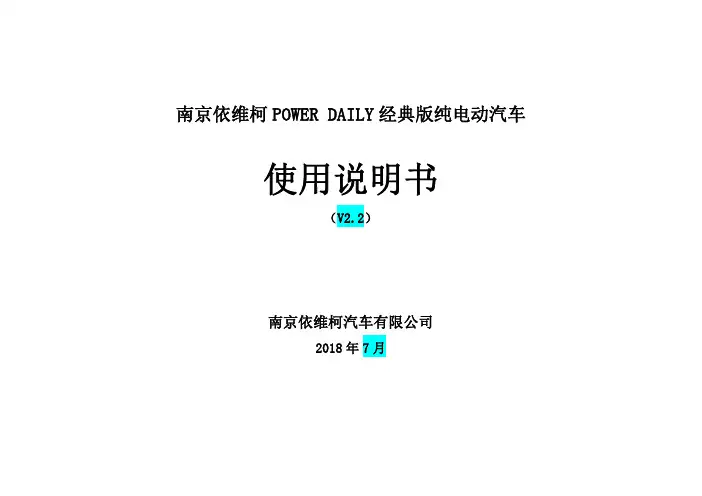
目录
说明与操作 .....................................1
汽车标识 ........................................................... 1 仪表板 ............................................................... 4 遥控钥匙 ........................................................... 6 车身防盗系统 ................................................... 9 中控锁 ............................................................. 11 前照灯光束调节 ............................................. 13 车门车窗 ......................................................... 13 双后开门 ......................................................... 16 *侧拉门 ........................................................... 17 驾驶员座椅 ..................................................... 18 安全带 ............................................................. 19 *安全气囊 ....................................................... 20 组合仪表 ......................................................... 23 报警灯符号 ..................................................... 24 TFT 显示屏....................................................... 28 左组合开关 ..................................................... 34 右组合开关 ..................................................... 36 危险警告灯 ..................................................... 37 雾灯开关 ......................................................... 37 带点烟器烟灰缸 ............................................. 39 整车控制器 VCU.............................................. 39 OBD 诊断接口................................................. 40 车内照明 ......................................................... 41 *应急小锤 ....................................................... 43
产品使用说明书范文5篇
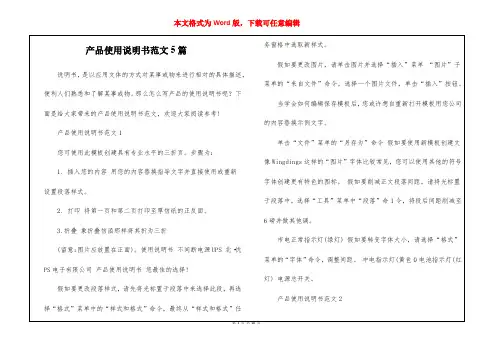
产品使用说明书范文 2
第 1 页 共 10 页
本文格式为 Word 版,下载可任意编辑
______ 衬套压入铆紧机 型号:_____ 编号: ____有限公司 公司名:___ 所在地:__ 电话号:__ 传真号:负责人:__ __ 名目 1-1 设备用途 1-2 设备技术参数 1-3 设备安装 1—4 设备润滑 2-1 运行预备 2-2 手动操作 2-3 自动操作 2-4 指示说明 2-5 报警解除说明 2-6 平安操作说明 3-1 主窗口说明 3-2 保持功能说明 3-3 波形比较功能说明 3-4 使用保存留意事项 4-1 主窗口说 明 4-2 设置
如有各种报警发生时,设备发出声光报警且运行停止。 ※若左侧有不合格件报警,则左侧自动过程停止,右侧在运行完
当前过程后停止。 产品使用说明书范文 3 1.概述 本产品为 LED-901 充电式手电筒,公司遵循国家行业执行标准:
GB7000.13-1999,确属本公司产品质量问题,自购置之日起保修期为 3 个(非正常使用而致使产品损坏,烧坏的,不属保修之列。)
第 7 页 共 10 页
本文格式为 Word 版,下载可任意编辑
在标准试验大气条件下,装置绝缘电阻满意表 2-2 所示要求。 表 2-2 装置绝缘电阻 试验部位绝缘电阻 100 兆欧 沟通电流回路对地用开路电压 500V 摇表测 沟通电流和沟通电压回路之间 沟通回路和直流回路之间 直流电源回路对地用开路电压 500V 摇表测 开入回路对地 开出接点对地 开入回路和开出接点之间 产品使用说明书范文 5 一、概述: 电茶炉试验台主要用于 CRH2/3(兼容 CRH5 型)动车组用的电热开 水器的电流、电压、功率、电热开水器的产开水温度、产开水量、缺
L100经典版JBL 标志性三分频书架式扬声器说明书
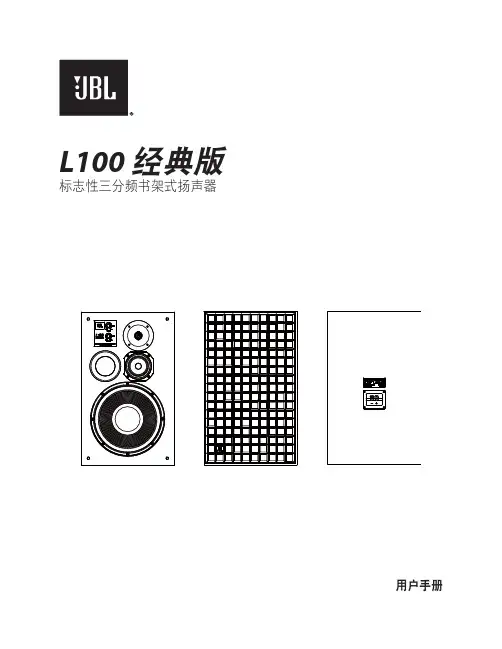
L100经典版标志性三分频书架式扬声器用户手册2感谢您购买 JBL® L100 经典版三分频扬声器逾 70 年来,JBL 一直为全球各地的音乐厅、录音棚和电影院提供音频设备,已成为领先的唱片艺术家和录音师的信赖之选。
传奇般的 JBL 4310 录音室专业监听音箱帮助 20 世纪六七十年代成功制作了许多热门专辑。
4310 是1970 年推出的 L100 家庭扬声器的灵感来源,成为 JBL 一直最畅销的扬声器。
L100 经典版是原先 L100 的当代再现。
全新的 L100 经典版向该历史经典致敬,采用了标志性的 12 英寸 (300mm) 三分频配置,还配备了全新驱动器、分频网络、机箱,使设计达到 21 世纪最高性能标准。
L100 经典版采用了紧凑的监听器类型占地空间设计,具有先进的 JBL 换能器,包括 JW300PW-8 纯纸浆锥盆低音扬声器、105H-1 聚合物包膜纯纸浆锥盆中音扬声器和 JT025TI1-4 钛高音扬声器。
L100 经典版保留了初始 L100 受七八十年代听众欢迎的所有性能属性,例如特殊的动态范围和对比度、清晰而轻松的高输出以及精确的高冲击低音。
更新的 L100 经典版添加了针对全带宽的更高细节分辨率、更低的失真度、更逼真的立体声声场成像,尤其是离轴。
L100 经典版必定在各地音乐爱好者中缔造新的传奇。
包装内容一个 L100 经典版扬声器 •一个 Quadrex 泡沫网罩 •一个 L100 经典版用户手册•摆放和定位警示:L100 经典版各重 58.8 lb. (26.7 kg)。
在将扬声器放在架子或平台上之前,请先确保架子或平台稳固,足以支撑扬声器的重量。
在决定扬声器的摆放位置之前,请测量您的房间并参考下图考虑摆放位置。
•切勿将扬声器放在功放、电热器等能够产生大量热量的设备附近。
切勿将扬声器放在潮湿或多尘位置。
• 切勿将扬声器放在阳光直射或有其他强光源的位置。
土建工程师岗位说明书(经典版)
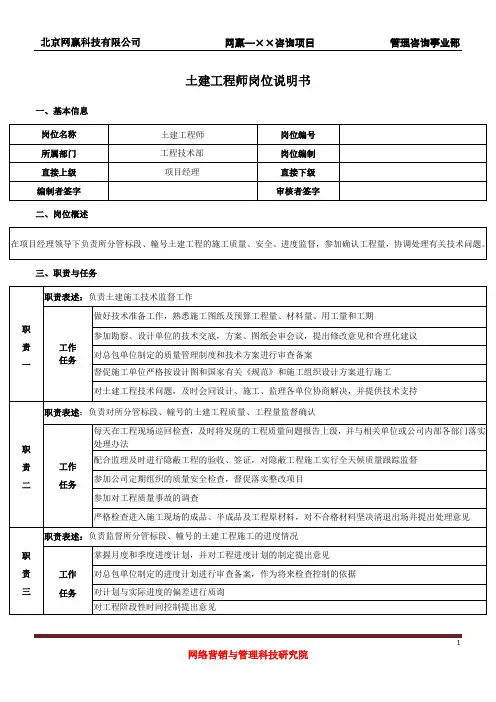
网赢—××咨询项目
管理咨Байду номын сангаас事业部
土建工程师岗位说明书
一、基本信息 岗位名称 所属部门 直接上级 编制者签字 二、岗位概述 在项目经理领导下负责所分管标段、幢号土建工程的施工质量、安全、进度监督,参加确认工程量,协调处理有关技术问题。 三、职责与任务 职责表述:负责土建施工技术监督工作 做好技术准备工作,熟悉施工图纸及预算工程量、材料量、用工量和工期 职 责 一 工作 任务 参加勘察、设计单位的技术交底,方案、图纸会审会议,提出修改意见和合理化建议 对总包单位制定的质量管理制度和技术方案进行审查备案 督促施工单位严格按设计图和国家有关《规范》和施工组织设计方案进行施工 对土建工程技术问题,及时会同设计、施工、监理各单位协商解决,并提供技术支持 职责表述:负责对所分管标段、幢号的土建工程质量、工程量监督确认 每天在工程现场巡回检查,及时将发现的工程质量问题报告上级,并与相关单位或公司内部各部门落实 处理办法 工作 任务 配合监理及时进行隐蔽工程的验收、签证,对隐蔽工程施工实行全天候质量跟踪监督 参加公司定期组织的质量安全检查,督促落实整改项目 参加对工程质量事故的调查 严格检查进入施工现场的成品、半成品及工程原材料,对不合格材料坚决清退出场并提出处理意见 职责表述:负责监督所分管标段、幢号的土建工程施工的进度情况 职 责 三 工作 任务 掌握月度和季度进度计划,并对工程进度计划的制定提出意见 对总包单位制定的进度计划进行审查备案,作为将来检查控制的依据 对计划与实际进度的偏差进行质询 对工程阶段性时间控制提出意见 土建工程师 工程技术部 项目经理 岗位编号 岗位编制 直接下级 审核者签字
职责表述:负责土建工程现场管理和协调工作 确认土建工程量,并在工程量确认联系单上出具意见 职 责 六 工作 任务 协调处理现场施工中出现的与施工图纸抵触和漏缺问题 及时解决工程中出现的突发性问题,并报告项目经理 负责联系工程相关单位,做好勘察、设计、施工、质监、监理等单位的协调工作 配合工程主管协调各施工、检测、质检等方面的工作 协调处理施工现场出现的各种临时性事务,处理土建施工过程中遇到的施工条件困难和问题 职责表述:参与工程验收工作,协助竣工后的决算工作 职 责 七 工作 任务 参与隐蔽工程验收和其他阶段性验收,并进行签证 参与工程竣工验收,并进行签证 对施工方的日常报验材料及时检验答复 协助公司有关部门对工程竣工后进行工程决算 职 责 八 职责表述:负责相关文件资料处理和整理归档工作 工作 任务 每天作施工记录,填写施工日记,详细记录当日处理事项和验收检查情况 负责编写和处理工程管理有关文件资料,妥善保管,有序存放,按规定交内勤管理员存档
(完全版)使用手册样板
(完全版)使用手册样板1. 简介欢迎使用本产品!本使用手册旨在为您提供关于产品的详细信息,帮助您更好地了解和使用本产品。
请在使用产品之前仔细阅读本手册,并按照说明进行操作。
2. 产品概述本产品是一款功能齐全的XXX设备,具有以下特点和功能:- 高效性能:采用最新的技术,提供出色的性能和稳定性。
- 易于使用:用户友好的界面设计,让您轻松上手。
- 多功能性:支持多种应用场景,满足您的不同需求。
- 优质服务:提供全面的技术支持和售后服务。
3. 安装与设置3.1 准备工作在安装和使用本产品之前,请确保以下准备工作已完成:- 检查包装内的配件是否齐全。
- 确保您的工作环境符合产品要求。
- 准备必要的工具和设备。
3.2 安装步骤请按照以下步骤进行安装:1. 步骤一:XXX2. 步骤二:XXX3. 步骤三:XXX3.3 设置与配置安装完成后,您需要进行以下设置和配置:1. 设置一:XXX2. 设置二:XXX3. 设置三:XXX4. 使用指南4.1 基本操作以下是一些基本操作的指导:1. 操作一:XXX2. 操作二:XXX3. 操作三:XXX4.2 高级功能如果您需要使用产品的高级功能,请按照以下步骤操作:1. 功能一:XXX2. 功能二:XXX3. 功能三:XXX5. 维护与保养为了确保产品的正常运行和延长使用寿命,请定期进行维护和保养。
以下是一些维护和保养的建议:1. 维护一:XXX2. 维护二:XXX3. 维护三:XXX6. 故障排除在使用过程中,您可能会遇到一些问题。
以下是一些常见的故障排除方法:1. 问题一:XXX解决方法:XXX2. 问题二:XXX解决方法:XXX3. 问题三:XXX解决方法:XXX7. 技术支持与售后服务我们为您提供全面的技术支持和售后服务。
如果您在使用过程中遇到任何问题或有任何疑问,请随时与我们联系。
- 客服电话:XXX- 邮箱地址:XXX- 官方网站:XXX8. 安全注意事项在使用本产品时,请务必注意以下安全事项:1. 请按照产品说明书进行操作。
最经典的Bioedit使用说明书-文档资料
Region 2: Position 1206 to 1222 Consensus: 1206 ACACGCGGGCUACAAUG 1222 Segment Length: 17 Average entropy (Hx): 0.0182 Position 1206 : 0.0000 Position 1207 : 0.0000 Position 1208 : 0.0000 Position 1209 : 0.0000 Position 1210 : 0.0708 Position 1211 : 0.0708 Position 1212 : 0.0000 Position 1213 : 0.1679 Position 1214 : 0.0000 Position 1215 : 0.0000 Position 1216 : 0.0000 Position 1217 : 0.0000 Position 1218 : 0.0000 Position 1219 : 0.0000 Position 1220 : 0.0000 Position 1221 : 0.0000 Position 1222 : 0.0000
4.General Vector properties
载体属性可通过选 “Vector” 菜单中的“Properties ”来更 改:
可以通过指定起点和末端位置,来增加多接头按 钮。多接头显示为“Courier New ”字体。 在这个对话框中,特征可以被编辑、增加或者删 除。想要编辑或删除一个现存的特征,在“Features” 下拉式菜单中选择特征,并点击合适的按钮。点击 “Add New” 按钮,可以增加一个新的特征。 现在只有一个圆形、单链质粒是有效的。在以后 的版本中中将会改进。
BioEdit version 5.0.9
MCNP使用说明--经典版
练习2a
绘制图象
%> mcnp i=demo1 n= demo1_ ip —概念 图象放大 全景显示 改变方向 验证材料,栅元,表面,密度等
学习目标:输入文件基础
了解MCNP中的物理单位 了解MCNP输入文件三个主要部分 了解MCNP输入文件的格式规定 了解MCNP输入文件的简写特点
余
表示栅元之外的空间 算符输入:在曲面号前用#
#5表示栅元5之外的空间
余以后的区域可以和 其他区域进行交和并 的运算
-2 #5代表曲面2之内
且在曲面5之外的区 域。
栅元
栅元输入卡包括三个部分
栅元号: 1-9999 栅元内容
材料号 材料密度
>0,表示原子密度 <0,表示质量密度
复合曲面
练习
截面测量实验
中央有一个圆柱孔(R=2cm)的铍球 (R=25cm)。 孔的中央有一个氚靶(厚0.5cm,R=2cm) 铍球嵌在半径为40cm的混凝土球壳内。
四类MCNP曲面
方程定义曲面
平面,球,圆柱,圆锥,圆环,任意的二次曲面
Macrobodies
基于闭合图元的复杂曲面
MCNP栅元:重要性
每个栅元都有重要性 标准的重要性为1
不同的数值用来表示重要性的递减
如果重要性为0,粒子在此栅元中不予考 虑
终结粒子历史 剩下的universe重要性为0
MCNP栅元:重要性的定义
IMP: n, IMP: p, IMP: e, IMP: n,p 等 两种方法定义重要性
岗位说明书模板(经典版)
(PerformanceAppraisal)
职业发展(CareerDevelopment)
可晋升岗位(Promote to)
可轮岗岗位(Rotate to)
入职培训(Orientation)
在职培训(On-job training)
是否有强制休假要求
(Imperative Vacation)
是否有定期或不定期强制轮岗要求(Imperative Rotation)
任职资格(Qualification)
教育背景(Education)
程度(Degree)
本科及以上
专业(Major)
证书(Certification)
专业技能(Skill)
语言(Language)
英语水平
其它
工作经验(Experience)
行业/职业
年限
职位
绩优素质能力(Competence)
修订履历
(Revision)
版本号
修订时间
修订内容
修订者
审核者
审批者
岗位说明书
识别信息
(Identification)
岗位名称
(Position)
岗位编号
(Code)
所属部门及处室
(Department)
工作地点
(Location)
工作关系(Connection)
直接汇报对象(Supervisor)
直接督导对象(Subordinate)
日常协调部门(Internal)
外部协调单位(External)
主要工作职责
(Duty&Responsbility)
工作目的(Purpose):
- 1、下载文档前请自行甄别文档内容的完整性,平台不提供额外的编辑、内容补充、找答案等附加服务。
- 2、"仅部分预览"的文档,不可在线预览部分如存在完整性等问题,可反馈申请退款(可完整预览的文档不适用该条件!)。
- 3、如文档侵犯您的权益,请联系客服反馈,我们会尽快为您处理(人工客服工作时间:9:00-18:30)。
目录第一部分经传·唯信号论第二部分软件基本操作第一章软件使用方法一安装和卸载软件二启动软件三指标的调用与切换的方法四涨跌幅排名和综合排名五图形组合六 K线信息的查看七设置自选股第二章菜单栏功能一系统功能二图线分析三基础功能四高级功能五资讯系统六帮助第三部分经传·经典版系列指标说明一慧眼K线二智能交易三智能辅助四海洋寻底五捕捞季节六主力统计七跟风统计八散户统计九水手突破十分类界面附录软件基础名词解释股票投资基础知识第一部分经传·唯信号论股市中的中小投资者,为实现股市中的投资梦想往往需要花费大量的时间、金钱、精力通过持之以恒的学习适应市场。
面对市场数以万计的资讯、数据、方法等大量信息,如何有效的进行鉴别,进行针对性的学习尤为关键。
我们生活在一个信息高度发达的时代,千里眼、顺风耳早已不是神话。
通过网络及广播电视媒体任何有关于市场的信息都能在最快速时间里从地球的一端传送至另一端。
谁最先获得了市场的信息那就能在在这个市场中获得领先的位置。
古语云:“早知三日便可富甲天下”,经传系列产品将从多个市场中为投资者提供第一手的数据及资讯。
经传信息致力于为中小投资者提供服务工具,不仅提供庞大的金融市场数据库信息,还将提供一系列识别有效信息的方法。
通过计算机系统强大的运算功能针对行情变化快速提取最真实、有效、及时的市场信息。
在经过概率、逻辑、主观的系统分析之后,实现真正的唯信号论、理性投资、长期生存的产品理念。
第二部分软件基本操作第一章软件使用方法一、安装和卸载软件1、软件的安装:1) 软件安装包(Setup.exe文件)的获得:方法一、在本公司附送的光盘上即可找到Setup.exe文件。
方法二、a.登录我公司网站:/ ,点击下载中心。
b.点击“马上下载”,出现窗口,下载本软件。
2) 开始安装:a.双击经典版20110104.exe 文件,运行安装程序。
b.阅读欢迎辞后点击“下一步”按钮图标进入许可使用协议界面。
c.阅读许可使用协议后,点击“我同意该许可协议的条款”并单击“下一步”按钮图标。
如果想改变安装位置,可以点击“浏览”,选择安装软件的目标文件夹。
d.接下来基本上可以直接点击“下一步”,直到出现“安装完成”界面,桌面上将自动生成经传·经典版的图标。
e.上述的任一步骤中,用户都可以点击“取消”来退出安装程序,经传·经典版将不被安装。
2、软件的卸载方法一、用户进入Windows操作系统之后,依次点击“开始→程序→经传·经典版”单击“卸载经传·经典版”项,就可以卸载经传·经典版软件了。
方法二、依次点击“开始→设置→控制面板”进入控制面板,双击“添加/删除程序”按钮图标,在当前安装的程序内选择“经传·经典版”,单击“删除”按钮图标进行卸载。
二、启动软件:1、双击桌面上“经传·经典版”快捷方式(如下图),即可进入经传·经典版软件的登陆界面:输入用户帐号、密码后,点右上角的“登录”即可。
见(图左):图左图右温馨提示:1)“行情”一栏,可以通过下拉菜单更换行情服务器。
用户可根据网络的速度选择相应的服务器,或者选择下面的选项“自动查找最快的主站”自动选择。
2)可选择是否保存您的帐号和密码,则下次登录不用再输入。
如果您是在公共场所使用本软件,请不要选择此项,以避免他人盗用.3)“通讯设置”一项可以设置IP代理。
当您所处的网络有某些限制时,通过设置该项可绕过封阻,图右。
在“使用代理”前打上勾,根据您的代理IP单选SOCK4协议,SOCK5协议或者HTTP代理,然后填上代理IP(如果不确定该IP是否能通过,可以先点击“测试代理”),确定。
4)“检测升级”同系统功能中的软件智能升级,详见第二章。
5)没有连接网络时,可以选择“脱机浏览”登陆。
6)主站测速,可以选择速度最快,最合适的服务器进行登录!为了您能更快更好的使用,建议选择综合值最小的主站!软件成功登陆后,直接打开“行情”或者点击软件左侧“行情浏览”即可进入行情浏览界面,该界面下方有“沪深A股”“行业板块”“自选股”“智能选股”“概念板块”“地区板块”六个选项,对应相关的板块。
在某个选项上点右键,可更换到不同的板块上。
三、指标的调用与切换的方法方法1、在K线图状态下选中某个指标窗(指标窗右边的边框明显的变粗),输入指标的名称,如输入“ZNFZ”,显示键盘精灵,选择相应的指标后按“回车”即可显示该指标。
方法2、鼠标移到软件界面最左边,点一下左键,弹出指标“控制面板”,选择相应的指标双击即可打开指标,双击其它指标可切换指标。
注:多个指标共存时,若要放大某一个指标窗,只要双击该指标窗任意区域即可放大(再双击则还原大小)。
四、涨跌幅排名和综合排名在键盘输入61(63)回车,打开上证(深证)涨幅排名。
单击“涨幅”则在涨幅和跌幅之间转换;输入81(83)回车,则可以打开上证(深证)综合排行榜,输入87为概念板块涨跌幅综合排名,88为行业板块涨跌幅综合排名,89为地区版块涨跌幅综合排名。
五、图形组合在K线界面任一处,点击“右键”—“画面组合”,可以选择:双图、三图、四图、五图、六图。
双图为K线图加成交量,三图则添加了一个指标窗;最多可同时容纳4个指标窗(六图)。
六、K线信息的查看在K线界面任一处双击,即可查看日K线的信息,双击历史K线,可看到历史分时走势!(K线的左下小图)七、设置自选股打开要设置为自选股的股票(K线或分时图均可),在主图上单击“右键”,选择“加入自选股”。
可选“新建自选股板块”或者“默认自选股板块”。
新建板块时用户可以随意命名(但不能重名)。
设置好自选股后,按F6即可在行情浏览界面调出所有的自选股。
若要按自选股板块单独显示,则可在行情浏览界面下方“自选股”处右键单击,然后选择相应的自选股板块,即可展示该板块的个股。
加入自选股的的个股,在行情浏览界面呈现蓝色状态,如下图所示:一、系统功能:包括软件升级、启动行情、断开行情、数据接收、系统设置、退出系统。
1、软件升级:经传公司会不断对软件进行完善和优化。
用户可通过该菜单升级到最新同级版本软件。
方法:点击“系统功能”→“软件升级”,在弹出的窗口“此操作将退出系统且删除所有本地安装文件。
并重新下载,“请确认?”中选“是”;在升级程序界面中(下图)点击“升级”,进入升级状态中。
升级完成后默认自动打开经传·经典版软件。
升级完成后要进行数据接收。
2、启动行情:方法:点击“系统功能”—“启动行情”,选择要连接的行情服务器,如下图的“华南电信网通”,即可连接到行情服务器上。
3、断开行情:需要更换服务器却不想重新登录软件时,可先点该项断开行情,然后重新启动行情服务器;计时上网的用户可在收盘完成数据接收后断开行情接收,以控制网费。
4、数据接收:是进行筛选股票和动力一号排序的必要前提!当天盘后3.30之后接收数据最稳定!方法:系统功能—盘后数据接收,将需要下载的选项打上钩,或点“全选”。
点击“开始下载”即可。
在这过程中还可点“隐藏”继续其它操作。
每次打开软件之后,软件会自动检测系统数据是否齐全,在数据没有接收的情况下,软件会自动提示用户接收收据。
5、系统设置:分为颜色设置,版面设置,端口设置,数据维护颜色设置:可根据个人喜好进行颜色的搭配版面设置:更改软件的两股对齐、字体大小及K线模式等。
“两股对齐”详见图线分析中的两股对比。
“K线模式”选择K线是实心还是空心;“主图指标”:选择叠加到K线上指标的个数,选择“叠加多个”表示允许多个指标同时显示在K线上,如同时显示智能辅助和短线波段指标。
点击图中所示可选择组合键对软件进行隐藏和恢复!端口设置:某些用户所处在的环境(如大型企业、国企等)可能会屏蔽一些端口,这时可通过配置行情端口,解除受限!数据维护:是清理历史的日K线数据,分时数据,至尊数据,财务数据等!6、退出系统:退出软件。
二、报价功能:包括综合排行榜、行情浏览、分时走势、K线分析、分钟线选择、多股同屏、多周期同屏、两股对比、画线工具、快捷控制面板。
1、综合排行榜:沪深A股以及板块综合排名,直接输入81、83快捷键调出!81-上证综合排名,83-深证综合排名。
88为行业板块综合排名。
87为概念板块综合排名。
89为地区板块综合排名。
2、行情浏览:显示实时行情信息!界面左下方可以选择沪深A股、行业板块、自选股、智能选股等分类(右键单击某一分类可显示该分类的子项)注:查看“换手率”时,需先下载财务数据和除权数据;“动力一号”则需接收盘后数据。
沪深A股:右键单击该项,可选择查看各大指数,如上海A股B股、深圳A股B股,上海指数等等。
行业板块:右键单击该项时可查看各大行业板块的个股信息,如地产板块、金融板块等。
自选股:管理自己设置的自选板块和自选股。
右键单击该项列出所有的自选股板块供选择。
智能选股:通过智能筛股功能选出的个股,可以在这里查看。
3、分时走势:个股分时走势图重要说明:成交量为分时图上的成交量量比是分时线上的即时量相对近段时期平均量的变化。
把当日每分钟不同的量比数值不断用点描绘在一个坐标中,就形成了量比曲线!委买委卖是最优的买卖盘的提示,它是未成交的价和量,某种程度上讲,委买委卖的差值(即委差),是投资者意愿的体现,一定程度上反映了价格的发展方向。
主力统计,监测分时行情主力波动!跟风统计,监测分时行情跟风波动!散户统计,监测分时行情散户波动!4、K线分析:打开个股的K线走势图。
K线与分时图的切换可直接按F5,或者输入“05”回车。
K线图界面包括个股走势、成交量、指标窗、筹码峰等组成,可以帮用户综合分析个股。
1)K线:看个股总体走势及形态;2)分价明细:看当天成交明细以及一些实盘信息;3)日K线信息:鼠标停在某K线实体上的时候,可显示当天该股的开、高、低、收等信息。
4)筹码峰:随鼠标移动而显示不同日期的筹码分布情况。
注:筹码峰需要接收盘后数据才能正确显示。
见“盘后数据接收”5、分钟线选择:分时、分笔、1分钟、3分钟、5分钟、10分钟、15分钟、20分钟、30分钟、60分钟、日K线、周K线、月K线、季K线、年K线、多K线。
亦可在K线区任一处点右键—分钟线选择。
其中多K线可以通过“系统版面设置”自定义。
6、多股同列:同时查看多个股票的分时走势图。
7、多周期同屏:同时查看一个股票的多周期K线形态。
8、两股对比:将两个股票进行对比分析。
点击该选项后,在两个K线区(分时区)分别输入两支需要对比的股票。
如果要想大盘和个股对比的,要先调出大盘K线,再点击两股对比。
9、:提供多种画线分析工具,如:趋势线、黄金分割线等。
10、快捷控制面板:见前面的“指标的调用与切换的方法”。
三、统计功能:智能选股、指标排序、阶段统计、市场雷达、计算数据。
